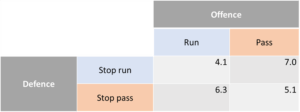Despite the name that indicates its regional confinement, American football is growing tremendously in international importance.
Even the most cynical sports grouch has in some form registered that the Super Bowl, the grand finale of the season, is happening this weekend, even if only for the glamorous half-time show or wickedly expensive advertising rather than the game itself. The Los Angeles Rams are playing the Cincinnati Bengals in Inglewood, California on Sunday night – or more precisely Monday morning at 12:30 AM CET. Contrary to public belief, despite all the showmanship and a certain inherent materialism, American football is much more than the violent encounter of two opposing teams. The game itself can be best described by the infamous quote: “American football is like chess but with fridges”.
Sequential nature of American football
For those of us in Europe, soccer is by far the most dominant sport. Whereas soccer is mostly a continuous game, in which only the mandatory half-time and penalties pause the game, American football is one of the most segmented sports in the world. Not only is the game stopped for 40 seconds after every play, which only take about 5-8 seconds each, but the team itself is highly compartmentalised. No player that plays on offence, plays on defence, and vice versa, thus creating highly specialised roles, further contributing to the highly strategic sequential nature of the game.
Two player zero-sum game
Without going into the nitty gritty details of the sport, American football is essentially a game where two teams try to advance a ball as far possible by employing a strategy, which in the best-case scenario is based on the actions of the other team. Furthermore, it is also a repeated game, since it is not a one-time decision, but rather approximately 150 plays in total per game. For every play, the offence can essentially choose between calling a pass play in which the quarterback advances the ball by throwing it, or running the ball by handing it to a running back who tries to run as far downfield as possible. Conversely, the defence is faced with the same choice, either employing a strategy to stop the run or to stop the pass. In game-theoretic terms only one “player” (i.e. team), can win, therefore a zero-sum two player game can be assumed.
Model
Mapping the efficiency of the offence in a simple metric (average yards gained per play (YPP), which inherently has some flaws, but is good enough for a simplified model) per the defence formation, we get the following table:

The table shows the average yards gained per play based on the choice of the offence (to run or to pass) and the choice of defence to stop the run or stop the pass.
The offence has no dominant strategy, meaning that neither strictly running nor passing is always better than the other. Therefore, offences should take a mixed strategy, rushing with probability P and passing with probability Q = 1-P.
At equilibrium, offence is indifferent to the defence trying to stop the pass and stop the run.
Expressed in a simple equation:
4.1P + 7(1-P) = 6.3P + 5.1(1-P)
Solving this gives P ≈ 46%. This suggests offences should rush 46% of the time. Offences in the National Football League (NFL) rushed on 41.5% of plays this year. But passes averaged 5.9 YPP compared to 4.2 YPP for rushes – which would suggest offences are running too much and should pass more. The simplified model is therefore not nearly enough to explain play-calling in the NFL.
Adding even more context to this model are advanced measures such as EPA (expected points added), which measure how a given play adds to the expected point total of the team. Even the best running teams are only able to generate 0.065 EPA per play, whereas the best passing offences of the league generate close to 0.220 EPA per play, so passes by these teams are more than three times more effective than runs by the best running teams.
Consequently, we see that even in a high-stakes environment, professionals do not necessarily behave rationally or according to game theory. Potential explanations for this behaviour are manyfold. One particularly common theory is that coaches fear the reputational damage they could suffer if they go against conventional football norms and are not completely successful.
Going beyond the simple model
Taking this oversimplified example of a binary pass or run choice even further into the context of the game, some fascinating questions arise. Offences that employ so called play-action passes (a pass play which starts off by faking a run play), are highly effective and have morphed even further into offensive juggernauts. A recent trend is to set players in motion before the actual play is initiated to gain information on the defensive formation, for example whether they plan to stop the run or the pass. Furthermore, the repeated game aspect allows for interesting insights into the deployed defensive strategy of teams. Some teams are almost religiously obsessed with designing plays which result in either a pass or run to look identical. For example, they run a certain play which results in a pass to gain information on the defence, so that they could implement a counter-play later in the game, which looks identical to the previous play, but is in fact a run.
Give it a try!
In short, there are tons of nuances that add to the fascination of American football. One can easily recognise the vast depth of game-theoretic implications that take place every second during the game of American football. So instead of dismissing American football as typical American materialism and bluster, why not give the highly strategic sport a try?
Photo by Dave Adamson on Unsplash
